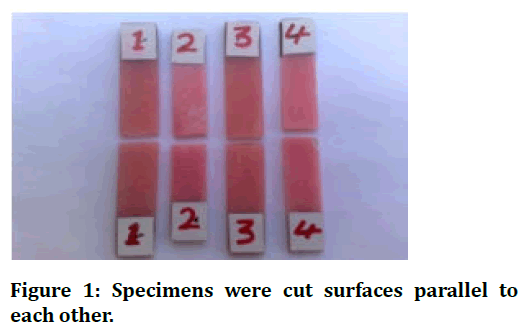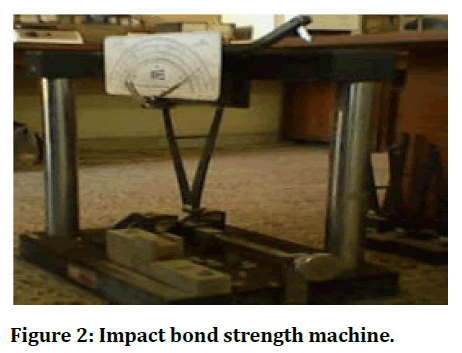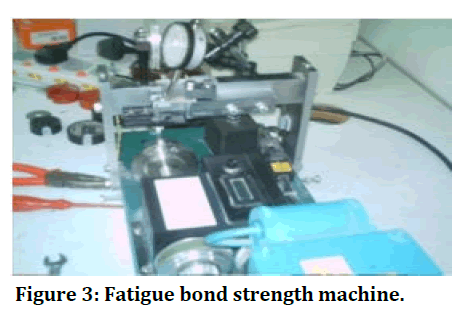Research - (2022) Volume 10, Issue 2
Some Denture Base Repairing Properties were investigated by Using a Variety of Surface Techniques
*Correspondence: Ibrahim H Alfahdawi, Department of Dentistry, Al-Maaref University College, Iraq, Email:
Abstract
Background: Since the 1930s, a variety of polymers have been utilized in dental operations to provide restorative dentistry, and their efficacy has been established by their morphological, biochemical, and biological properties. Inadequate design, fabrication, and/or material selection are all common causes of denture breakage. Objective: The study's goal is to test the fatigue and impact bond strength of dentures repaired using light-cured acrylic resins using various chemical solvents such as acetone, monomer, and thinner (in vitro). Materials and procedures: Heat-cure acrylic resin is used, and six sets of specimens are made using specially constructed molds, as directed on the box (5 specimens for each cured polymerization). Specimens were cut in guiding mode with a conventional positioning clamp. The samples' terminals were soaked in several solvents before repairing, including acetone, thinner, and monomer. To evaluate impact strength, silicon sheets with diameters of (50×5×4) mm were created. On an alternative bending fatigue machine, specimens with a diameter of (70× 10 X 2.5) mm were evaluated. Results: The monomer solvent's impact bond strength was found to be higher than that of the thinner solvent and the acetone solvent. Thinner solvents and monomer solvents have a lower fatigue bond strength than acetone. Acetone, thinner, and monomer were utilized as solvents, and the results of all surface treatments revealed substantial changes in mean value. Conclusions: The monomer solvent's impact bond strength was found to be higher than that of the thinner solvent and the acetone solvent. Thinner solvents and monomer solvents have lower fatigue bond strength than acetone. Acetone, thinner, and monomer were utilized as solvents, and the results of all surface treatments revealed substantial changes in mean value.
Keywords
Acrylic resin, Repairing, Impact bond strength, Fatigue bond strength, Surface treatments
Introduction
A multitude of resins were used in dental procedures for the production of dental prosthesis ever since 1930s, and their success has already been based on physical, chemical, and biological qualities. Initially, denture bases were made of nitrocellulose, vulcanite, venyl plastics, phenol formaldehyde, and porcelain. The acrylic resins have been so favourably embraced by the practitioner that by 1946, methyl methacrylate polymers or copolymers were used to make 98% percent of all denture bases [1].
Initially, the conversion of the monomer to polymer, that is commonly accomplished using a hot water bath or a microwave, is needed for the polymerization of such a resin [2,3]. Interest for the good properties, suitable strength, poor water sorption, poor solubility, in moreover to being free of toxicity, easy repair ability, the ability to reproduce accurately the features and size of pattern, and easiness of plaster molds and processing technique have all contributed to the success of acrylic resin as denture bases [4,5]. Denture breaking is frequently caused by inadequate design, production, and/or material selection. Denture fails beyond the mouth as a consequence of the prosthesis being ejected from the mouth during coughing or falling the denture. Excessive gripping pressure within the mouth can potentially cause fractures [6,7]. Cracks with in midline of maxillary full dentures seem to be more frequent [6,8]. Moreover, instead of in the middle of the restoration, denture failures frequently develop near the junction of past and present materials [9].
The goal of prosthesis repair is to restore the natural form and strength of the denture for the least amount of money and time feasible. A number of treatments and materials were used to repair frayed prosthesis. To repair damaged acrylic resin prostheses, auto polymerized acrylic resin, heat curing acrylic resin, and, most recently, visible lightcuring acrylic resin are utilized [10,11]. The rate of acrylic resin prosthesis failure because of broken has been shown to be accepted [12].
Acrylic plastic has long been the most popular and wellliked of all denture base materials, accounting for over 95% of all plastics used in prosthodontics [13,14]. Metallic and non-metallic materials are the two types of materials utilized as denture foundations [15,16]. Nothing has yet been found that can match the appearance of the soft tissues of the mouth as well as acrylic resin. It is not only visually beautiful when first placed in the mouth, but it also retains its beauty over time provided the patient follows a simple cleaning and hygienic care regimen [17]. Such dental resins are frequently given in two parts: a liquid monomer called methyl methacrylate (MMA) and a powder called polymer [18].
The purpose of this research is to test the fatigue bond strength and impact bond strength of light-cured acrylic resins in denture repair using various chemical solvents such as acetone, monomer, and thinner (in vitro).
Materials and Procedures
Heat-cur acrylic resin was used with carefully prepared molds to create six sets of specimens, as directed by the manufacturer (5 specimens for each cured polymerization). A powder and liquid combination is created at room temperature ( ± 23ºC) and allowed to reach the dough phase for 20 minutes. After the molds have been entirely filled with dough resin. Acrylic resins that have been heat-polymerized are put into molds and treated in according to the manufacturer's specifications. The acrylic denture base material was cured simply immersing the clamped flask in water and completing a quick curing cycle (1.5 hour at 74ºC followed by half hour at 100ºC) according to ADA standard No.12; 1999 [19]. Once curing was complete, The flask was allowed to cool slowly before being used before deflasking at normal temperature. After then, the specimens were taken out of the stone mold. All of the flatter form access was removed with a straight acrylic bur. The surfaces would be smoothed with a stone bur, then sanded to remove any remaining tiny scratches. A bristle brush and pumice were used to polish on the lathe polishing machine. A glossy sheen was obtained by polishing the surface with a wool brush and soap. The specimen is squeezed in 74°C water for 8 hours [20].
In guiding, specimens were cut using a consistent positioning jig. Cut surfaces were produced by abrading under water perpendicular to the surface and parallel to each other specimens' long axis silicon carbide paper to duplicate roughing of the denture surface repairing using laboratory burs. Ends of specimens bathed in various solvents (Figure 1) (acetone, thinner, and monomer before repair).

Figure 1. Specimens were cut surfaces parallel to each other.
Perform an impact bond strength test: To evaluate the impact bond strength, silicone sheets with a width of (50× 5× 4) mm were made. Specimens were created and stored in distilled water at 37°C until they were totally saturated (2 weeks). The impact samples were collected out of the water and maintained in the air for an hour before being tested [19]. Impact bond strength is generally determined by the amount of work required to fracture a test piece. The testing machine was a charpy type machine tester, with varying weight tubs (pendulums) depending on the strength of the materials to be tested. A swinging pendulum anchored the specimen at two ends and kept it in position in the centre of the tested section; the average readings provided the impact energy in joules. The quantity of energy received by the specimen is shown in Figure 2.

Figure 2. Impact bond strength machine.
A (Hi-Tech company, England) alternative bending fatigue machine was used to test the ten samples with a dimension of (70 X 10 X 2.5) mm. Millions of cycles might be done in a couple of hours because of the tremendous speeds. The drawback is that complete reversal is the sole stress management option accessible. A new form of fatigue machine was invented to overcome this problem, in which a cantilever could be deflected to apply varying bending forces on it. Figure 3 shows how the free end of a cantilever is propelled up and down using a reciprocating mechanism.

Figure 3. Fatigue bond strength machine.
Results and Discussions
As demonstrated in Table 1, the impact strength of monomer solvent (3.16 ± 0.59) is stronger than that of thiner solvent (2.29 ± 0.65) and acetone solvent (1.98 ± 0.99).
| Solvent | Acetone | Thiner | Monomer |
|---|---|---|---|
| Mean | 1.985 | 2.499 | 3.162 |
| SD | 0.998 | 0.658 | 0.597 |
| ANOVA F-test=2.772 P=0.049 P<0.05 Significant | |||
Table 1: Descriptive of impact strength.
This is consistent with the findings of [21,22], who observed that adding monomer solvent material to both old and fresh acrylic enhanced stiffness, toughness, and chemical bond cohesion.
As indicated in Table 2, the fatigue strength of the acetone solvent (7760 ± 136) was larger than that of the thinner solvent (980 ± 887) and monomer solvent (221 ± 129). Our findings corroborated those of [23-26] who found that certain solvent materials for treatment strengthened the cohesiveness acrylic resin, old and new, resulting in a fatigue life value larger than the acrylic resin. Acetone, thinner, and monomer were utilized as solvents, and the results of all surface treatments showed a substantial difference at (P- value).
| Solvent | Acetone | Thinner | Monomer |
|---|---|---|---|
| Mean | 9800 | 77600 | 2210 |
| SD | 8874 | 1366 | 1298 |
| ANOVA F-test=0.957 P=0.412 P>0.05 Non Significant | |||
Table 2: Descriptive of fatigue strength.
Conclusion
The monomer solvent's impact bond strength was found to be higher than that of the thinner solvent and the acetone solvent. Thinner solvents and monomer solvents have lower fatigue bond strength than acetone. Acetone, thinner, and monomer were utilized as solvents, and the results of all surface treatments revealed substantial changes in mean value.
Conflict of Interest
There are no relevant conflicts of interest for the writers of this work.
Acknowledgments
The author appreciates the assistance of Al-Maaref University College and the department of dentistry.
References
- Anusavice KJ, Shen C, Rawls HR. Phillips' science of dental materials. Elsevier Health Sciences 2012.
- Nishii M. Curing of denture base resins with microwave irradiation: with particular reference to heat-curing resins. J Osaka Dent Univ 1968; 2:23-40.
- Kimura H, Teraoka F, Saito T. Application of microwave for dental technique (part 2). Adaptability of cured acrylic resins. J Osaka Univ Dent School 1984; 24:21-29.
- Alfahdawi IH, Jaber SA, Alshamaa AA. Evaluation of the tensile, compressive strengths and surface hardness of reinforced heat cured acrylic resins with glass fibers. Latin Am J Pharm 2021; 40:216-220.
- Alfahdawi IH. Effect type of flasking technique and investing materials on movements of teeth during complete denture construction. Int Med J 2019; 26:516-519.
- Stipho HD, Stipho AS. Effectiveness and durability of repaired acrylic resin joints. J Prosthet Dent 1987; 58:249-253.
- Polyzois GL, Andreopoulos AG, Lagouvardos PE. Acrylic resin denture repair with adhesive resin and metal wires: Effects on strength parameters. J Prosthet Dent 1996; 75:381-387.
- Beyli MS, Von Fraunhofer JA. An analysis of causes of fracture of acrylic resin dentures. J Prosthet Dent 1981; 46:238-2441.
- Shen C, Colaizzi FA, Birns B. Strength of denture repairs as influenced by surface treatment. J Prosthet Dent 1984; 52:844-848.
- Naji GA. Influence of various chemical surface treatments, repair materials, and techniques on transverse strength of thermoplastic nylon denture base. Int J Dent 2020; 2020.
- Atalay S, Çakmak G, Fonseca M, et al. Effect of thermocycling on the surface properties of CAD-CAM denture base materials after different surface treatments. J Mech Behav Biomed Mater 2021; 121:104646.
- Cunningham JL. Bond strength of denture teeth to acrylic bases. J Dent 1993; 21:274-80.
- Sakaguchi RL, Powers JM. Craig's restorative dental materials-e-book. Elsevier Health Sciences 2012.
- Craig RG. Prosthetic applications of polymers. Chapter 21 2002; 636- 656.
- Anthony DH, Peyton FA. Dimensional accuracy of various denture-base materials. J Prosthet Dent 1962; 12:67-81.
- Chevitarese O, Craig RG, Peyton FA. Properties of various types of denture-base plastics. J Prosthet Dent 1962; 12:711-719.
- Smith LT, Powers JM. In vitro properties of light-polymerized reline materials. Int J Prosthod 1991; 4.
- Phillips RW. Elements of dental materials. 4th ed. WB. Saunders Co. 1984; 130- 150.
- Council on Dental Materials and Devices. Revised American dental association specification no. 12 for denture base polymers. J Am Dent Assoc 1975; 90:451-458.
- Sipahi C, Ozen J, Ugur Ural A, et al. The effect of two fibre impregnation methods on the cytotoxicity of a glass and carbon fibre‐reinforced acrylic resin denture base material on oral epithelial cells and fibroblasts. J Oral Rehab 2006; 33:666-673.
- Jagger DC, Jagger RG, Allen SM, et al. An investigation into the transverse and impact strength ofhigh strength'denture base acrylic resins. J Oral Rehab 2002; 29:263-267.
- Jagger D, Harrison A, Jagger R, et al. The effect of the addition of poly (methyl methacrylate) fibres on some properties of high strength heat‐cured acrylic resin denture base material. J Oral Rehab 2003; 30:231-235.
- Cardash HS, Applebaum B, Baharav H, et al. Effect of retention grooves on tooth-denture base bond. J Prosthet Dent 1990; 64:492-496.
- Takahashi Y, Chai J, Takahashi T, et al. Bond strength of denture teeth to denture base resins. Int J Prosthod 2000; 13:59-65.
- Abu-Anzeh MI, Al-Dhaher A. Evaluation of tensile bond strength of tooth denture base resin as a function at different surface treatments and processing regimes. A master thesis, College of Dentistry, University of Baghdad. 2003.
- Al-Fahdawi IH. Evaluation of fatigue and impacted bond strengths of denture base repaired by using different type of surface treatment. Tikrit J Dent Sci 2015; 3:16-21.
Indexed at, Google Scholar, Cross Ref
Indexed at, Google Scholar, Cross Ref
Indexed at, Google Scholar, Cross Ref
Indexed at, Google Scholar, Cross Ref
Indexed at, Google Scholar, Cross Ref
Indexed at, Google Scholar, Cross Ref
Indexed at, Google Scholar, Cross Ref
Indexed at, Google Scholar, Cross Ref
Indexed at, Google Scholar, Cross Ref
Indexed at, Google Scholar, Cross Ref
Indexed at, Google Scholar, Cross Ref
Indexed at, Google Scholar, Cross Ref
Indexed at, Google Scholar, Cross Ref
Indexed at, Google Scholar, Cross Ref
Author Info
Department of Dentistry, Al-Maaref University College, IraqReceived: 27-Jan-2022, Manuscript No. JRMDS-22-51086; , Pre QC No. JRMDS-22-51086 (PQ); Editor assigned: 10-Jan-2022, Pre QC No. JRMDS-22-51086 (PQ); Reviewed: 24-Jan-2022, QC No. JRMDS-22-51086; Revised: 27-Jan-2022, Manuscript No. JRMDS-22-51086 (R); Published: 03-Feb-2022
